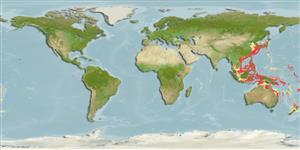Environment: milieu / climate zone / depth range / distribution range
Ecology
Marine; demersal; depth range 50 - 400 m (Ref. 11230). Tropical
Indo-West Pacific: widespread with confirmed range from Western Australia to French Polynesia and from southern Japan to northern New Zealand. Specimens recorded from the Indian Ocean may represent an undescribed species.
Size / Weight / Age
Maturity: Lm ? range ? - ? cm
Max length : 30.0 cm TL male/unsexed; (Ref. 2272)
Dorsal soft rays (total): 4 - 5. This species is distinguished by having a rounded body disc which is slightly wider than long; strongly pointed tubercles on dorsal surface and body margins; interspaces of entire body covered with tiny spinules; reddish body with short vermiculate pattern on dorsal surface (Ref. 92977).
Found in the shelf and shelf edge (Ref. 11230). Used in Chinese medicine (Ref. 12166).
Life cycle and mating behavior
Maturity | Reproduction | Spawning | Eggs | Fecundity | Larvae
Ho, H.-C., C.D. Roberts and K.-T. Shao, 2013. Revision of batfishes (Lophiiformes: Ogcocephalidae) of New Zealand and adjacent waters, with description of two new species of the genus Malthopsis. Zootaxa 3626(1):188-200. (Ref. 92977)
IUCN Red List Status (Ref. 130435: Version 2024-1)
Threat to humans
Harmless
Human uses
Fisheries: bycatch
Tools
Special reports
Download XML
Internet sources
Estimates based on models
Preferred temperature (Ref.
123201): 13.7 - 25.8, mean 19.4 °C (based on 334 cells).
Phylogenetic diversity index (Ref.
82804): PD
50 = 0.5020 [Uniqueness, from 0.5 = low to 2.0 = high].
Bayesian length-weight: a=0.01479 (0.00517 - 0.04233), b=2.93 (2.68 - 3.18), in cm total length, based on LWR estimates for this (Sub)family-body shape (Ref.
93245).
Trophic level (Ref.
69278): 3.4 ±0.6 se; based on size and trophs of closest relatives
Resilience (Ref.
120179): Low, minimum population doubling time 4.5 - 14 years (Preliminary K or Fecundity.).
Fishing Vulnerability (Ref.
59153): Low vulnerability (20 of 100).
